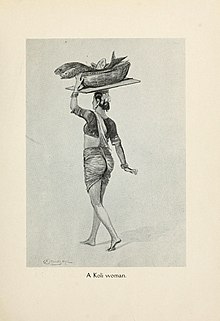Koli people
कोली, કોલી, कोळी | |
|---|---|
Muslim, Christian | |
| Related ethnic groups | |
| Kori, Koli Christians |
The Koli is an Indian caste found in Rajasthan, Himachal Pradesh, Gujarat, Maharashtra, Uttar Pradesh, Haryana, Karnataka,[1] Odisha[2] and Jammu and Kashmir states in India.[3] Koli is an agriculturist caste of Gujarat but in coastal areas they also work as fishermen along with agriculture. In the beginning of 20th century, the Koli caste was recognised as a denotified tribe under Criminal Tribes Act by the Indian Government because of their anti-social activities during World War I.
The Koli caste forms the largest caste-cluster in Gujarat and Himachal Pradesh, comprising 24% and 30% of the total population in those states respectively.[4][5]
History
Early

There has historically been some difficulty in identifying people as Koli or as
Records of Koli people exist from at least the 15th century, when rulers in the present-day Gujarat region called their chieftains marauding robbers,

Through the colonial
Twentieth century

During the later period of the Raj, the Gujarati Kolis became involved in the process of what has subsequently been termed
In 1947, around the time that
The relevance of the Kshatriya label in terms of ritual was diminished by the practical actions of the KKGKS which, among other things, saw demands for the constituent communities to be classified as
The Kolis of Gujarat remained educationally and occupationally disadvantaged compared to communities such as the

Shial
The Shial, or Shiyal is a clan of Koli caste found in the Indian state of Gujarat. They were noted pirates of Gujarat.[18] The Shial Kolis got their name from the Shial island situated at south coast of Kathiawar.[19] Shial Kolis defeated and captured the Shial island from Portuguese India and made it their stronghold along with Chanch, Gujarat but later they were defeated by Nawab of Janjira and Jafrabad.[20] during the World War I, they were enlisted as soldiers in British Indian Army by British Indian government.[21]
Classification
The Koli community classified as
The
Criminal Tribes Act
The Koli caste of
See also
Notes
- Kanbi, but by 1931 had gained official recognition as Patidar.[13]
References
- ^ "Koli community hopeful of getting ST tag in Karnataka – Times of India". The Times of India. Retrieved 8 April 2019.
- ^ "Odisha – List of Scheduled Tribes" (PDF). ST & SC Development, Minorities & Backward Classes Welfare Department Government of Odisha. Archived from the original (PDF) on 19 August 2021. Retrieved 16 May 2021.
- ^ "Jammu and Kashmir BJP in favour of reservation for people living along international border". The New Indian Express. Archived from the original on 8 April 2019. Retrieved 8 April 2019.
- ^ a b Shah 2004, p. 221.
- ISBN 978-81-7387-080-4.
- ^ Shah 2012, p. 168
- ISBN 978-9-38060-702-3.
- JSTOR 538561– via JSTOR.
- ^ Shah 2012, p. 169
- ^ a b c d e Jaffrelot 2003, pp. 180–182
- ^ Fuller 1975, pp. 293–295
- ^ a b Shah 2012, p. 170
- ^ a b Basu 2009, pp. 51–55
- ^ Basu 2009, p. 52
- ^ Basu 2009, p. 53
- ^ Shah 2004, p. 178.
- ^ Shah 2004, p. 302.
- ISBN 978-0-19-908959-8.
- ^ Campbell, James M. (1988). Hindu Castes and Tribes of Gujurat. New Delhi, India, Asia: Vintage Books. pp. 245: Shiale.
- ^ The West India Pilot. New Delhi, India: J. D. Potter. 1987. p. 36.
- ^ A Short Record of Bombay Recruiting During the Great War. New Delhi, India: Printed at the Government Central Press. 1919. p. 17.
- ^ "A community called Koli – Indian Express". archive.indianexpress.com. Retrieved 7 March 2022.
- ^ "Who is stirring the caste cauldron in Karnataka?". Hindustan Times. 1 March 2021. Retrieved 7 March 2022.
- ^ "CENTRAL LIST OF OBCs FOR THE STATE OF MAHARASHTRA" (PDF).
- ^ "कोली को अनुसूचित जाति का दर्जा नहीं: हाईकोर्ट".
- ^ "List Of Scheduled Tribes – TRTI, Pune". trti.maharashtra.gov.in. Retrieved 7 March 2022.
- ^ "N.C.T. Delhi : DATA HIGHLIGHTS: THE SCHEDULED CASTES : Census of India 2001" (PDF). Censusindia.gov. Retrieved 3 October 2015.
- ^ "Madhya Pradesh : DATA HIGHLIGHTS: THE SCHEDULED CASTES : Census of India 2001" (PDF). Censusindia.gov. Retrieved 3 October 2015.
- ^ "Rajasthan : DATA HIGHLIGHTS: THE SCHEDULED CASTES : Census of India 2001" (PDF). Censusindia.gov. Retrieved 3 October 2015.
- JSTOR 26552652.
- ISBN 978-0-19-563956-8.
- ISBN 978-0-521-36424-9.
- ISBN 978-81-7154-807-1.
- Bibliography
- Basu, Pratyusha (2009), Villages, Women, and the Success of Dairy Cooperatives in India: Making Place for Rural Development, Cambria Press, ISBN 9781604976250
- Fuller, Christopher John (Winter 1975), "The Internal Structure of the Nayar Caste", Journal of Anthropological Research, 31 (4): 283–312, S2CID 163592798
- ISBN 9781850653981
- ISBN 978-1-13619-770-3
- Shah, Ghanshyam (2004), Caste and Democratic Politics In India (Reprinted ed.), Anthem Press, ISBN 9781843310860
Further reading
- Bayly, Susan (2001). Caste, Society and Politics in India from the Eighteenth Century to the Modern Age. Cambridge University Press. ISBN 9780521798426.
- James, V. (1977). "Marriage Customs of Christian Son Kolis". Asian Folklore Studies. 36 (2): 131–148. JSTOR 1177821.
External links
- Plants and animals important to the Koli-Agri community in Maharashtra Archived 11 January 2020 at the Wayback Machine on Biodiversity of India
- A community called Koli – The Indian Express
